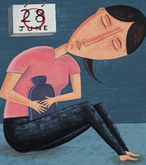|
A woman is generally referred to a gynecologist by a health care provider if she is experiencing any
pain or difficulty with her period. These problems can include (Click on each title to find out more information):

A much more severe form of the symptoms known as premenstrual
syndrome (PMS).
Premenstrual dysphoric disorder (PMDD) affects approximately 3
percent to 9 percent of women of reproductive age and is considered a severe and chronic medical condition that requires
attention and treatment.
The exact cause of PMDD is not known but one belief is that women
may have abnormal reactions to normal hormone changes that occur with each menstrual cycle.
Symptoms appear a week or two before menstruation and disappear within a few days after it starts. Symptoms may include irritability,
nervousness, constipation, anger, insomnia, difficulty in concentrating, depression, severe fatigue, anxiety, bloating,
nausea, vomiting, paranoia, pelvic pressure, moodiness and sleep disturbances.
There are no specific medications identified to treat it but various
treatments may alleviate PMDD symptoms including dietary modifications, regular exercise, stress management, vitamin supplements,
anti-inflammatory medications, selective serotonin reuptake inhibitors (SSRI) and oral contraceptives.

Painful menstrual periods are marked by crampy lower
abdominal pain. A woman may feel sharp pain that comes and goes or have dull, aching pain and may also experience mild
to severe back pain.
The pain may begin several days before or just at the start of your period. It generally
subsides as menstrual bleeding tapers off. Although some pain during menstruation is normal, excessive pain is not. The medical
term for excessively painful periods is dysmenorrhea.
Approximately 10 percent experience contractions so extreme that they are one and
a half times more powerful than labour pains.
Caused by high levels of prostaglandins, a hormone that increases the normal
squeezing or contraction of the muscle in the wall of the uterus.
Many women will experience other symptoms such as nausea, vomiting, diarrhea/constipation,
fainting, light-headedness, feeling dizzy, headaches and exhaustion.
Treatment may include exercise, over the counter painkillers, anti-inflammatory
drugs, oral contraceptive pills and Mirena intra-uterine system (IUS).
If none of these treatments work, your doctor might want to check for ovarian cysts,
endometriosis, fibroids or pelvic inflammatory disease.
Amenorrhoea is the absence of periods (menstruation).
Usually, but not always, it also means no eggs are produced.
Primary amenorrhoea is the failure for girls to begin menstruation by the age
of 16.
Secondary amenorrhoea is defined as the absence of menstruation for six consecutive
months in a woman who previously had regular periods.
Causes of amenorrhoea may include stress, ovarian disorders such as polycystic ovaries, hormonal problems, rapid weight loss often caused by an eating disorder, strenuous physical activity, certain drugs such as antidepressants and chromosomal abnormalities.
Treatment for amenorrhea is dependent
upon the cause of the condition. For example amenorrhea caused by hormonal irregularity may be treated with hormonal
therapy and weight related amenorrhea may be treated by improved diet.

- If you soak through a sanitary pad or tampon every hour for 6 consecutive hours,
this is considered a very heavy period.
- A prolonged period is one that lasts longer than 7 days.
- Bleeding may be something to worry about if it occurs between
periods, after intercourse, or if you are over age 50, especially if you have already gone through menopause.
- Causes of these types of periods include anovulation (failure
of ovaries to produce, mature, or release eggs), endometrial polyps (the endometrium is the inner lining of the uterus), endometrial
hyperplasia (thickening/build up of the uterine wall), endometrial cancer, uterine fibroids, miscarriage or ectopic pregnancy,
hormonal changes, recent trauma, surgery, pelvic inflammatory disease, stress and dramatic weight loss or gain.
- Keep a record of your menstrual cycles, including when menstruation
begins and ends, how much flow you have (count numbers of pads and tampons used, noting whether they are soaked), and any
other symptoms you experience.
- A hysteroscopy D&C (dilation and curettage) may be performed
to determine the cause of the bleeding. Treatment may include prostaglandin inhibitor, female hormones such as oral contraceptive
pills and in the extreme cases, a hysterectomy may be required.

Vaginal Bleeding Between Periods
- Intermenstrual bleeding is bleeding from the uterus that occurs between menstrual periods. You should
always consult your general practitioner if you experience significant bleeding between your periods.
- Causes may include hormonal imbalance, IUD use, breakthrough bleeding on the contraceptive pill, cervical
polyp (tiny, harmless growth on the outer surface of the cervix can bleed after intense sexual intercourse), pelvic inflammatory
disease, cervical erosion (the process where the cells of the cervix begin to grow on its outer surface), miscarriage or cervical
cancer.
|
